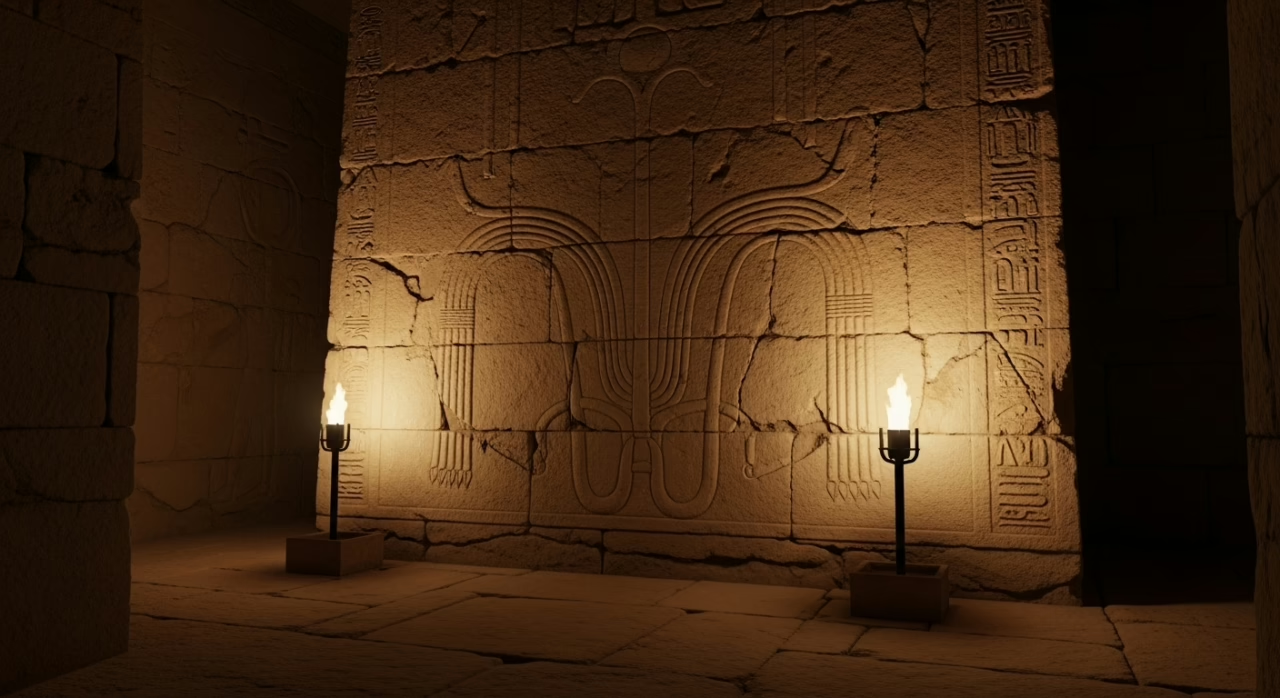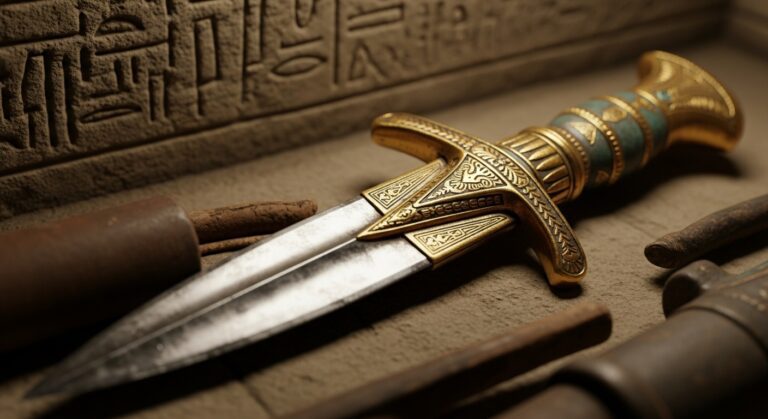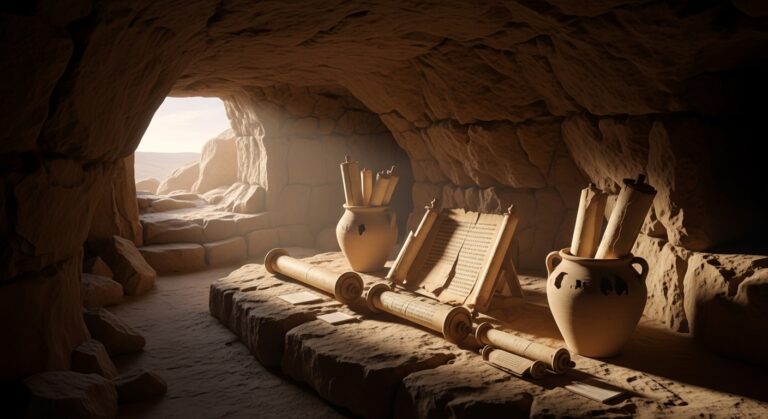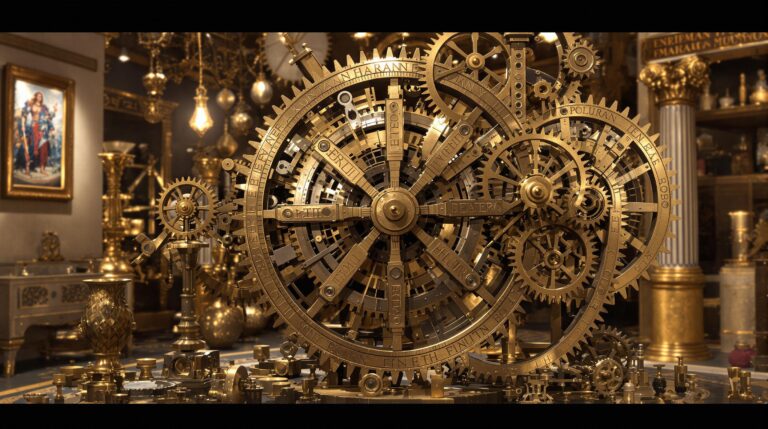Ancient Egyptian Light Bulb Mystery Explained
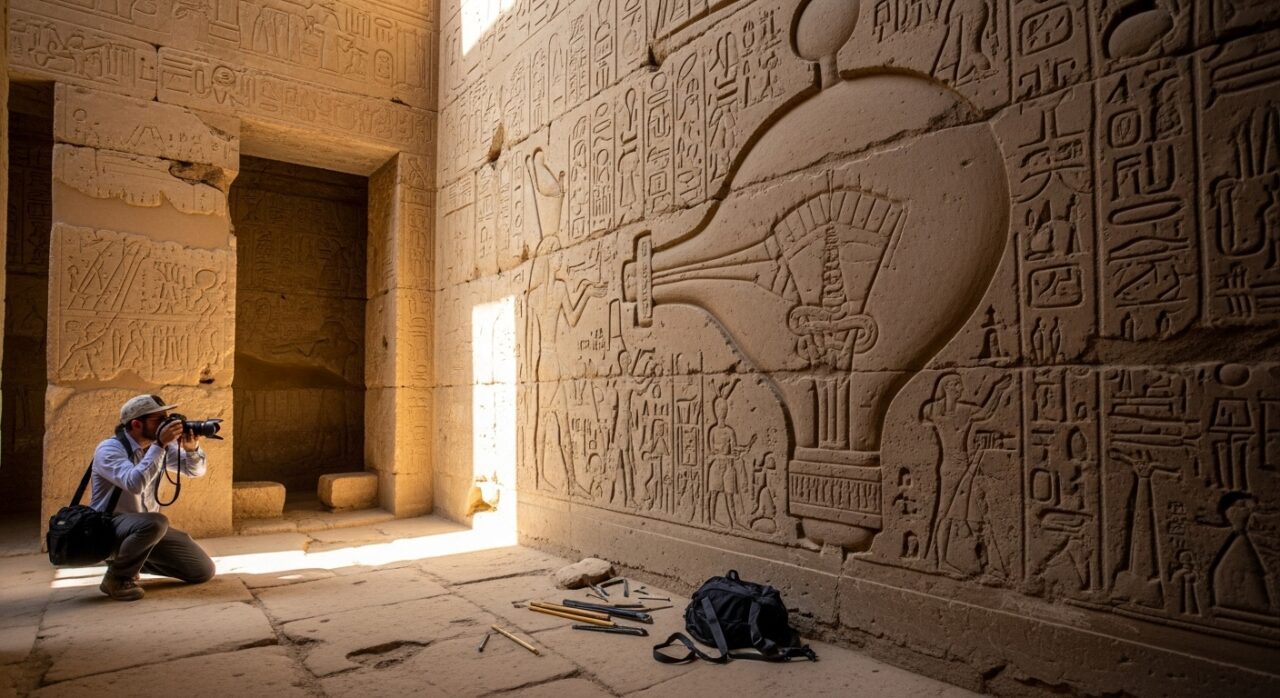
Ancient Egyptian Light Bulb Theory – The enigmatic reliefs of Egypt’s Dendera Temple have sparked contentious debate among scholars and enthusiasts alike.
These stone carvings, dating to the Ptolemaic period, seemingly depict elongated, bulb-like structures that bear an uncanny resemblance to modern electrical lighting.
Despite surface similarities to Geissler tubes or primitive lamps, mainstream Egyptologists interpret these images as symbolic representations of lotus flowers and serpents—motifs deeply embedded in Egyptian cosmology.
What secrets might these ancient artisans have encoded in stone?
Highlights
Hide- The Dendera Temple relief depicts what some interpret as an ancient light bulb, but mainstream Egyptologists identify it as lotus and serpent religious symbolism.
- Proponents claim the relief shows electrical components like filaments and cables, suggesting advanced ancient technological knowledge.
- No archaeological evidence of electrical infrastructure or components has been found to support the ancient Egyptian light bulb theory.
- The imagery aligns with established Egyptian religious iconography representing creation, rebirth, and the myth of Harsomtus, a serpent deity.
- This controversy highlights tensions between traditional archaeological interpretations and alternative theories about ancient technological capabilities.
Setting the Scene: The Dendera Temple Relief
The enigmatic carvings discovered within the Dendera Temple Complex in Egypt, dating to the Ptolemaic period, ignited fierce academic debate when they were first documented by European explorers in the late 19th century.
Etched into the stone walls of a subterranean crypt, the relief depicts what appears to be an elongated bulb-like object containing a serpentine element, suspiciously similar to modern electric lamps, with Egyptian priests standing nearby in seemingly ritualistic poses.
The distinctive imagery—featuring what some interpret as a cable connected to a supposed power source resembling Djed pillars—challenges conventional understandings of ancient technological capabilities, leaving archaeologists and historians divided between orthodox explanations involving lotus symbolism and more controversial theories suggesting advanced knowledge of electricity.
Similar to Babylon’s documented astronomical advances, these carvings highlight how ancient civilizations often developed sophisticated knowledge systems that modern interpretations struggle to contextualize.
The Discovery That Sparked the Debate
The enigmatic relief carvings discovered in the Hathor Temple at Dendera, dating to the Ptolemaic period (circa 50 BCE), captivated archaeological circles when they emerged from obscurity during Napoleon’s Egyptian expedition of 1798.
Mainstream Egyptologists initially interpreted these unusual images as symbolic representations of fertility and creation, with the elongated forms representing lotus flowers, snakes, or boats carrying deities across the celestial waters.
The controversy ignited, however, when alternative theorists observed the striking resemblance between these ancient carvings and modern electrical devices, particularly what appeared to be glass bulbs with serpentine filaments connected to what could be interpreted as power sources.
This debate emerged during a time when many scholars were still lamenting the lost knowledge repositories that might have contained ancient Egyptian technological insights had they survived the destruction of the Library of Alexandria.
Where the image was found and how it gained attention
Nestled within the cryptic corridors of Egypt’s Dendera Temple complex, a peculiar bas-relief carving caught the discerning eye of archaeologists in the late 19th century, igniting a controversy that continues to simmer among scholars, alternative historians, and technological enthusiasts today.
This intriguing relief, located in a subterranean chamber of the Hathor sanctuary, gained prominence through archaeological publications documenting the temple’s rich ancient symbolism and cultural context.
Similar to how the architectural landscape of Thinis reflected its inhabitants’ priorities and values, the Dendera reliefs provide a window into the cultural identity and religious practices of ancient Egyptians.
Initial interpretations from mainstream Egyptologists
Mainstream Egyptologists initially dismissed the sensationalized theories surrounding the Dendera carvings, offering instead a culturally contextualized interpretation rooted in established hieroglyphic analysis.
They identified the imagery as religious symbolism representing the Egyptian lotus flower, with its bulbous shape and extending serpent symbolizing rebirth, not ancient technology.
Archaeological context and historical accuracy mattered more than speculative connections to modern inventions.
The precision in these carvings resembles the precision in construction found at Angkor Wat, which similarly challenges our understanding of ancient knowledge.
The Carving’s Appearance and Details
The controversial Dendera relief depicts an elongated, bulbous shape supported by what appears to be a cable-like structure and base, reminiscent to modern eyes of an oversized light bulb with filament.
Inside this “bulb” writhes a serpent, traditionally representing divine power in Egyptian cosmology, while lotus flowers—symbols of creation and rebirth—adorn the base of the structure.
The surrounding hieroglyphics and figures, including representations of Harsomtus (a manifestation of Horus) and various ritualistic elements, provide vital context that mainstream Egyptologists interpret through traditional religious frameworks rather than technological ones.
Similar to the reinterpretation of ancient symbolism at Göbekli Tepe, these debates highlight how archaeological discoveries challenge conventional timelines of human technological development.
Description of the “bulb-like” shape and supporting elements
Carved onto the ancient stone walls of Dendera Temple, a peculiar relief captures the imagination of modern viewers with its uncanny resemblance to electrical technology.
The centerpiece of this artistic carving features an elongated, bulb-like vessel supported by what appears to be a lotus flower base, while serpentine lines extend from it—inspiring alternative bulb interpretations that challenge conventional understandings of ancient designs and symbolic motifs.
Similar to Minoan frescoes, this relief may represent visual storytelling that reflects cultural values and religious symbolism rather than technological knowledge.
Symbolism commonly associated with Egyptian iconography
Ancient Egyptian hieroglyphs and artistic representations thrived on symbolic language, where every element carried layered meanings beyond mere decoration.
Egyptian deities, mythological representations, and symbolic motifs formed an intricate visual vocabulary understood by initiates of their cultural significance.
- Lotus flowers symbolized rebirth and creation
- Ankh represented eternal life and divine connection
- Djed pillar embodied stability and the backbone of Osiris
Similar to the story of Iram of Pillars, Egyptian artistic elements often contained moral lessons about power, hubris, and divine accountability.
Scientific and Historical Interpretations
The Dendera reliefs have ignited a scholarly battleground between traditional archaeological explanations and more controversial electrical interpretations.
Conventional Egyptologists maintain that the carvings represent symbolic lotus flowers, snake symbols, and mythological boats—elements deeply rooted in Egyptian religious iconography, with the apparent “bulb” merely representing a djed pillar or fertility symbol.
Alternative theorists, however, point to the striking visual similarities between the reliefs and modern electrical components, suggesting that the elongated bulb-like structure, internal filament-resembling snake, and apparent insulator base constitute evidence that ancient Egyptians may have possessed rudimentary electrical technology, thousands of years before its official discovery.
Similar debates surround other ancient civilizations, including the interpretations of colossal stone heads created by the Olmecs, where speculation often overshadows archaeological evidence.
Traditional Explanations from Archaeology
The supposed “light bulb” carvings at Dendera Temple have been conventionally interpreted by Egyptologists as depictions of the lotus flower, a powerful symbol of creation and rebirth in ancient Egyptian cosmology, often paired with serpent imagery to represent divine knowledge.
This traditional reading connects the controversial reliefs to the myth of Harsomtus, “He Who Unites the Two Lands,” a serpent deity born from the sacred lotus that served as a manifestation of royal legitimacy and cosmic order.
The intricate temple artistry therefore reflects sophisticated theological concepts rather than anachronistic technology, with the lotus-serpent motif appearing throughout Egyptian sacred architecture as a visual codification of creation narratives that anchored pharaonic authority to divine origins.
Like the Carthaginian purple dye trade that symbolized economic power in the Mediterranean, these Egyptian religious symbols represented spiritual authority in the Nile valley.
Lotus flower and snake as religious motifs
Symbolic representations etched into ancient Egyptian artifacts consistently feature lotus flowers and serpents, motifs that archaeologists have long recognized as carrying profound religious significance throughout the civilization’s three-thousand-year history.
Cultural representation evolution reveals deeper meanings:
- Lotus symbolism significance embodied rebirth and solar cycles
- Snake mythology origins connected to both protection and chaos
- Religious motifs influence extended beyond decorative purposes into cosmology
Ancient iconography analysis suggests these symbols weren’t technological illustrations but spiritual expressions.
Similar to how Hittite writing systems preserved cultural myths and facilitated the exchange of complex ideas across ancient civilizations, these Egyptian symbols served as vehicles for religious concepts rather than technical diagrams.
Role of the Harsomtus myth in temple art
Ancient depictions of Harsomtus, the divine serpent emerging from a lotus flower, illuminate temple walls throughout Upper and Lower Egypt, representing a foundational mythological narrative central to understanding supposed “electrical devices” in Egyptian reliefs.
This Harsomtus symbolism, prevalent in temple iconography, embodies the primordial moment of creation—when light first emerged from darkness, a concept deeply embedded in Egyptian mythology whose religious significance transcends decorative function.
Arguments Citing Electrical Concepts
Proponents of the ancient Egyptian “light bulb” theory often focus on structural similarities between the enigmatic Dendera Temple reliefs and modern electrical components, pointing to shapes they interpret as filaments, sockets, and connecting cables.
Some researchers, most prominently alternative archaeologist Christopher Dunn, have suggested these etchings represent a sophisticated understanding of electrical principles, potentially used for illuminating underground chambers where no soot evidence from conventional flame lighting has been found.
This electrical interpretation connects to broader “ancient technology” theories that posit advanced knowledge was possessed by earlier civilizations but subsequently lost, either through catastrophe or deliberate suppression.
The “filament,” “socket,” and “cable” comparisons
When examining the Dendera light reliefs, adherents of alternative theories often point to several features they interpret as electrical components, specifically drawing parallels between elements in the carvings and parts of modern light bulbs.
- The serpent inside the bulb-shaped object is frequently identified as a “filament,” despite mainstream archaeological explanations of it representing symbolic mythology.
- Socket interpretations focus on the lotus flower base as an electrical connection point.
- Cable connections supposedly depicted by the undulating “power lines” may actually represent ancient Egyptian cosmological concepts.
Theories linking to ancient electricity use
The hypothesis of ancient Egyptian mastery of electrical technology represents one of the most persistent and controversial reinterpretations of archaeological evidence from the temples at Dendera.
Proponents suggest these ancient innovations imply lost knowledge of electric potential, enabling technological advancements far beyond conventional historical timelines.
The implications of lighting systems in subterranean chambers, where soot residue is remarkably absent, challenges traditional explanations of tomb illumination methods.
Alternative Theories and Fringe Claims
The “Ancient Electricity Hypothesis,” embraced by proponents of alternative archaeology, suggests that certain hieroglyphic depictions in Egyptian temples potentially represent sophisticated electrical technology that has been lost to time.
These controversial interpretations, particularly of the famous Dendera light bulb relief, propose that ancient Egyptians harnessed electrical power through mechanisms resembling primitive batteries, despite the absence of corroborating physical evidence in the archaeological record.
Speculative connections to a supposed lost technological civilization extend beyond Egypt to other ancient cultures, forming part of a broader narrative that challenges conventional historical understanding of technological development in the ancient world.
The Ancient Electricity Hypothesis
Some alternative theorists contend that ancient Egyptian tomb carvings depicting what appear to be bulb-like structures provide evidence of practical electrical lighting systems that illuminated sacred chambers, challenging conventional archaeological narratives about technological capabilities in antiquity.
These proponents often draw parallels to the controversial “Baghdad Battery,” clay jars discovered in Iraq that some suggest functioned as primitive galvanic cells capable of generating small electrical currents through electrolyte solutions.
The ancient electricity hypothesis, while dismissed by mainstream Egyptologists who attribute the alleged “light bulb” depictions to lotus flowers and mythological symbolism, continues to captivate those seeking technological discontinuities in human history—apparent anomalies that suggest knowledge lost or deliberately concealed across millennia.
Proponents who suggest practical lighting in tombs
While conventional archeology explains tomb illumination through reflective mirrors or oil lamps, proponents of the ancient electricity hypothesis argue that sophisticated electrical lighting systems existed in Egyptian tombs, enabling the creation of elaborate, soot-free wall paintings in sealed underground chambers.
Key advocates point to several observations:
- The absence of smoke residue on meticulously preserved tomb paintings
- Alleged electrical components depicted in hieroglyphic reliefs resembling modern bulbs
- The impracticality of traditional lighting methods for the complex ancient artistry
Comparisons to the Baghdad Battery theory
Much like the contentious Baghdad Battery—a clay jar containing copper and iron elements discovered in modern-day Iraq—proponents of ancient Egyptian electricity draw compelling parallels between these alleged archaic power sources.
Both historical artifacts suggest sophisticated ancient technology capabilities, despite mainstream archaeological rejection.
The electrical theories surrounding these items propose rudimentary power generation systems that challenge conventional understanding of technological development, offering tantalizing glimpses into potentially misunderstood ancient knowledge.
Speculative Connections to Lost Technology
Proponents of lost ancient technology theories have identified what they claim are copper wires embedded in sealed chambers within certain Egyptian artifacts, suggesting the presence of electrical conductors in a configuration reminiscent of primitive batteries.
These speculations extend to interpretations of hieroglyphic depictions showing figures holding bulb-shaped objects with snake-like elements inside, which some fringe researchers interpret as filaments within ancient light bulbs.
The academic community, however, has largely rejected these interpretations, citing lack of physical evidence, problematic decontextualization of imagery, and the absence of any supporting infrastructure that would be necessary for a genuine electrical technology to function in ancient Egypt.
Claims about wire conductors and sealed chambers
Numerous fringe theorists have proposed that certain Egyptian tomb reliefs depict ancient electric lighting systems, complete with alleged wire conductors and hermetically sealed chambers essential for functioning bulbs.
These claims typically highlight:
- Serpentine symbols interpreted as filaments within glass bulbs
- Inscriptions purportedly showing technological innovations beyond conventional archaeological context
- Sealed ceramic vessels that supposedly prevented oxygen from extinguishing ancient illumination devices
Objections from academic communities
Almost universal rejection characterizes the academic community’s response to the “ancient Egyptian light bulb” hypothesis, with Egyptologists, archaeologists, and historians citing substantial evidence contradicting these fringe interpretations.
Critical analysis reveals that proponents often decontextualize temple reliefs, ignoring historical context and established archaeological understanding.
Academic skepticism stems from methodological issues in fringe science approaches, which favor alternative theories over rigorous examination of primary sources, technological capabilities, and cultural practices of ancient civilizations.
Investigating Evidence Beyond the Relief
When examining the provocative Dendera light bulb theory, scholars encounter a profound evidentiary void: no physical examples of ancient electrical devices, conductive metals arranged as circuitry, or generation infrastructure have ever been discovered in Egypt’s archaeological record.
This conspicuous absence challenges proponents to explain how an electrically advanced civilization would leave behind only a single, ambiguous carved relief while failing to preserve any tangible components of such revolutionary technology.
The relief must consequently be considered within the broader context of Egyptian temple iconography, where lotus flowers, serpents, and creation mythology regularly appear together in religious art without requiring technological interpretations.
Lack of Supporting Artifacts or Infrastructure
Despite thorough excavations of countless Egyptian tombs, temples, and settlements spanning millennia, not a single wire, power source, or actual light bulb mechanism has ever been recovered to substantiate the contentious “Dendera light bulb” theory.
The complete absence of physical infrastructure necessary to produce or maintain electric lighting—no generation facilities, no conductive materials, no insulators—speaks volumes against technological interpretations of the curious relief.
Perhaps most tellingly, Egyptian tombs and enclosed spaces lack the characteristic soot patterns that would inevitably accompany flame-based illumination alternatives, suggesting either skilled ventilation systems or entirely different methods for maneuvering through darkness that historians continue to investigate.
No wires, power sources, or bulbs recovered
Critics of the “ancient Egyptian light bulb” theory point to a glaring absence in the archaeological record: no physical remains of electrical infrastructure have ever been recovered from ancient Egyptian sites.
Despite extensive excavations of technological advancements throughout Egypt, researchers note:
- No copper wires or conducting materials resembling electrical components
- Absence of power-generating devices or batteries
- No glass bulbs or specialized containers for electrical phenomena
Absence of soot and what it might indicate
Three compelling pieces of archaeological evidence emerge when examining the absence of soot in Egyptian tombs and temples.
First, the pristine walls challenge conventional wisdom about ancient technology, suggesting alternative explanations beyond simple torch illumination.
Second, the archaeological implications of soot-free chambers align with symbolic interpretations emphasizing purity in the afterlife.
Finally, when viewed within proper cultural context, this absence could represent sophisticated knowledge that defies traditional historical narratives.
Context Within the Broader Temple Art
The alleged “light bulb” relief at Dendera cannot be studied in isolation, as similar artistic configurations appear throughout Egyptian temples, tombs, and sacred structures, suggesting a pattern rather than an anomaly.
These repetitive motifs, when analyzed within their broader artistic context, reveal consistency with established mythological symbolism rather than technological documentation.
The design elements follow conventional Egyptian artistic principles where objects, deities, and cosmic symbols were arranged according to religious significance, not practical function—a vital perspective often overlooked by alternative theorists who extract singular images from their cultural framework.
Similar depictions across other locations
Archaeological discoveries across multiple Egyptian temples reveal similar anomalous depictions that parallel the controversial “light bulb” reliefs found at Dendera, challenging researchers to contemplate whether these representations constitute isolated artistic oddities or components of a broader symbolic tradition.
Cultural exchanges between ancient civilizations may explain these recurring motifs:
- Abydos temple contains comparable serpentine figures with bulbous enclosures
- Karnak complex features similar lotus-and-serpent combinations in ceremonial contexts
- Valley of Kings tombs display related mythological parallels with enigmatic interpretations
How symbolic and mythological art guided design
Examining these contentious reliefs from Dendera and their counterparts across Egyptian sacred sites requires expanding our analytical scope to encompass the rich symbolic language that permeated all aspects of ancient Egyptian artistic expression.
The design influence of religious iconography, coupled with mythological inspiration, created a cultural significance beyond literal interpretation. Their artistic expression communicated cosmic relationships through symbolic representation, transmitting esoteric knowledge through carefully constructed visual metaphors.
Modern Influence and Pop Culture
The Dendera Relief has transcended its archaeological context to become a cornerstone of pseudoscientific narratives about ancient advanced technology, appearing in documentaries, conspiracy websites, and science fiction that reimagines Egypt’s technological capabilities.
Educational institutions increasingly use this contentious artifact as a case study in critical evaluation, challenging students to distinguish between evidence-based archaeology and speculative interpretation.
Beyond classrooms and fringe theories, the image has permeated popular imagination, compelling society to confront the tension between our desire for mysterious ancient wisdom and the methodical, often less sensational conclusions of mainstream science.
The Relief’s Role in Pseudoscience and Media
The enigmatic Dendera “light bulb” relief has become a mainstay in pseudoscientific documentaries and speculative fiction, where it regularly features as evidence of advanced ancient technology or extraterrestrial intervention.
Popular television series like “Ancient Aliens” have transformed this obscure archaeological curiosity into a globally recognized symbol of alternative history, attracting millions of viewers who find conventional explanations of ancient achievements unsatisfying.
Despite scholarly dismissal of these interpretations, the relief’s mysterious imagery continues to captivate public imagination across cultural boundaries, demonstrating how archaeological ambiguity can transcend academic discourse to become a powerful icon in modern pop culture.
Appearances in documentaries and fiction
Numerous documentaries and fictional works have seized upon the Dendera light bulb theory, transforming this archaeological curiosity into a staple of alternative history entertainment.
Documentary interpretations frequently misrepresent historical evidence to support predetermined conclusions about ancient technology.
- The History Channel’s “Ancient Aliens” prominently features the relief
- Science fiction novels incorporate the concept as proof of advanced Egyptian knowledge
- Hollywood films leverage these cultural reflections despite glaring historical inaccuracies
How fringe theories attract interest globally
Why do fringe theories about ancient Egyptian technology captivate global audiences despite overwhelming scientific evidence to the contrary?
The intersection of ancient mysteries with speculation trends creates a perfect storm for global interest, particularly when established narratives seem restrictive.
Fringe theories offer alternative explanations that challenge institutional authority, while public perception increasingly values independent investigation over academic consensus.
This reflects a broader cultural fascination with hidden knowledge and suppressed histories.
Educational Use and Critical Thinking
The “Dendera light bulb” controversy offers a unique educational opportunity to teach critical thinking skills and archaeological literacy in classrooms worldwide.
By encouraging students to compare the relief with confirmed historical tools and technologies, educators can demonstrate how evidence must be evaluated within its proper cultural and historical context.
This archaeological mystery serves as a powerful case study for distinguishing between evidence-based conclusions and speculative interpretations, challenging students to question extraordinary claims while appreciating the genuine technological achievements of ancient civilizations.
Teaching skepticism and archaeological literacy
How might educators harness the enduring mystery of the “Dendera light bulb” to cultivate critical thinking skills among students?
The relief provides an ideal case study for teaching critical analysis and evidence evaluation within proper cultural context. Through myth debunking exercises, students learn historical accuracy while developing archaeological literacy.
- Comparing pseudoarchaeological claims against scholarly consensus
- Examining primary sources versus popular interpretations
- Recognizing how modern perspectives influence historical understanding
Encouraging comparisons with confirmed historical tools
Rather than dismissing alternative theories outright, educators can implement comparative analysis between the Dendera carvings and well-documented ancient technologies to foster nuanced critical thinking.
Ongoing Questions and Responsible Inquiry
The enigma of the alleged ancient Egyptian light bulb continues to perplex archaeologists and historians today, with fundamental questions about the technological capabilities of this ancient civilization remaining unanswered.
Despite decades of scrutiny and debate, scholars remain divided on whether the Dendera relief depicts actual electrical technology or represents symbolic religious imagery, a controversy sustained by the limited archaeological evidence and the challenge of interpreting ancient iconography without imposing modern technological frameworks.
Responsible academic inquiry demands a balanced approach that acknowledges both the fascinating possibility of advanced ancient knowledge and the methodological requirement to ground extraordinary claims in extraordinary evidence, particularly when alternative explanations rooted in established historical context remain viable.
What Still Isn’t Known
Despite extensive archaeological investigation, scholars still debate the authentic meanings of certain Egyptian ritual depictions found in tomb reliefs and papyri, which some fringe theorists have controversially interpreted as electrical devices.
The possibility remains that modern observers, influenced by contemporary technological frameworks, may misinterpret symbolic or religious imagery that held entirely different significance within ancient Egyptian cultural contexts.
These interpretations require careful, methodical analysis rooted in established archaeological principles rather than speculative leaps that project current technological understanding onto civilizations separated from us by millennia.
Unresolved questions about ancient Egyptian rituals
Why centuries of Egyptological research have failed to fully illuminate the mysteries shrouding ancient Egyptian ritual practices remains a compelling question for modern scholars and enthusiasts alike.
Several aspects of their spiritual meanings and ritual significance continue to elude definitive understanding:
- Precise relationships between celestial bodies and religious symbolism
- Transmission methods of secretive ancient practices among priest classes
- Cultural beliefs governing technological knowledge and its sacred applications
Possibilities of symbolic representations we misread
How might modern scholars fundamentally misinterpret ancient symbolic representations due to our contemporary cognitive frameworks?
The Dendera “light bulb” illustrates how symbolic interpretations can be distorted through modern technological lenses, overlooking the cultural influences and historical contexts embedded in these artistic representations.
Properly analyzing these artifacts demands rigorous reinterpretation methods that respect the complex religious symbolism Egyptians conveyed through their distinctive visual language.
Why the Debate Persists
The enduring allure of the so-called “Dendera light bulb” controversy reflects humanity’s persistent fascination with unsolved ancient mysteries, where tantalizing visual evidence seems to challenge conventional historical narratives.
Scholars must carefully navigate between legitimate archaeological questions and the seductive domain of pseudoscience that often conflates visual similarity with functional equivalence, particularly when modern interpretations are retroactively imposed on ancient iconography.
The tension between mainstream archaeological consensus and alternative historical interpretations creates a fertile ground for ongoing debate, highlighting the critical need for methodological rigor while acknowledging the powerful cultural impulse to discover lost ancient knowledge that might connect our technological present with humanity’s distant past.
Public fascination with ancient mysteries
Throughout human history, the enigmatic pull of ancient mysteries has captivated public imagination, creating an enduring fascination that transcends generations and cultures.
This historical intrigue manifests particularly through:
- Archaeological fascination with artifacts defying conventional explanations
- Cultural narratives that preserve mystery appeal through folklore and speculation
- Ancient technologies suggesting capabilities beyond traditional historical timelines
The Dendera light bulb controversy exemplifies this phenomenon perfectly.
The line between alternative history and speculation
Despite rigorous academic standards governing mainstream archaeological discourse, a persistent tension exists between conventional historical narratives and alternative interpretations of ancient artifacts like the Dendera carvings.
The area of alternative theories often treads a precarious line; while some researchers pursue genuine historical interpretation within appropriate cultural context, others disconnect artifacts from their mythological significance, prompting justified academic skepticism.
This differentiation—between responsible inquiry and unfounded speculation—remains vital for meaningful archaeological dialogue.
Wrapping Up
The ancient Egyptian “light bulb” remains not an artifact of lost technology, but a reflection of our enduring fascination with the past.
While enthusiasts see electricity, scholars recognize religious symbolism; where some find conspiracy, historians uncover cultural context.
The Dendera reliefs invite us to appreciate ancient wisdom on its own terms—not as precursors to modern inventions, but as windows into a civilization’s profound relationship with divinity, creation, and rebirth.
- Aldred, C. (1980). Egyptian art. Thames & Hudson.
- Assmann, J. (2001). The search for God in ancient Egypt (D. Lorton, Trans.). Cornell University Press.
- Badawy, A. (1968). A history of Egyptian architecture: The empire (the New Kingdom). University of California Press.
- Brier, B. (1999). The murder of Tutankhamen: A true story. Berkley Books.
- Dunn, C. (2010). Lost technologies of ancient Egypt: Advanced engineering in the temples of the pharaohs. Bear & Company.
- Faulkner, R. O. (1969). The ancient Egyptian pyramid texts. Oxford University Press.
- Fischer, H. G. (1986). The symbolic orientation of ancient Egyptian temples. Metropolitan Museum Journal, 21, 7–19. https://doi.org/10.2307/1512800
- Frankfort, H. (1948). Kingship and the gods: A study of ancient Near Eastern religion as the integration of society and nature. University of Chicago Press.
- Hornung, E. (1999). The ancient Egyptian books of the afterlife (D. Lorton, Trans.). Cornell University Press.
- Iversen, E. (1961). The myth of Egypt and its hieroglyphs in European tradition. Gad.
- Kákosy, L. (1995). Magic in ancient Egypt. Budapest: Hungarian Egyptian Society.
- Murnane, W. J. (1980). The Penguin guide to ancient Egypt. Penguin Books.
- Rohl, D. M. (1995). A test of time: The Bible from myth to history. Century.
- Scheel, B. (1989). Egyptian metalworking and tools. Shire Egyptology.
- Snape, S. (2011). Ancient Egyptian tombs: The culture of life and death. Wiley-Blackwell.
- Wilkinson, R. H. (2003). The complete gods and goddesses of ancient Egypt. Thames & Hudson.
- Wilkinson, R. H. (2000). The complete temples of ancient Egypt. Thames & Hudson.
- Yoyotte, J. (1993). Light and lamps in Pharaonic Egypt. In L. B. Hunt (Ed.), Ancient Egyptian technology (pp. 51–62). British Museum Press.
